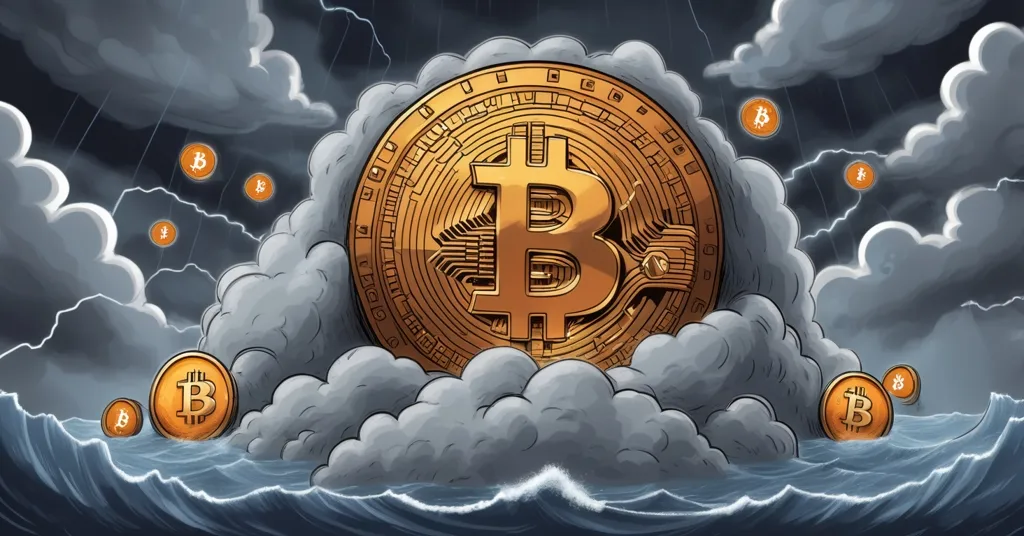Bitcoin Nears All-Time High: Embraced as Safe Haven Amid Global Turmoil

Bitcoin Surges Toward New All-Time High, Recognized as Safe Haven Amid Global Instability
Bitcoin is pushing the boundaries once again, nearing its all-time high as it’s increasingly seen as a safe haven asset amidst growing global instability. Industry leaders like Chainlink’s Sergey Nazarov and Robinhood Crypto’s Johann Kerbrat are spotlighting Bitcoin’s transformation, suggesting it’s decoupling from tech stocks and behaving more like gold.
- Bitcoin’s new safe haven status
- Decoupling from tech stocks
- Corporate Bitcoin holdings surge
- Trading close to all-time high
Sergey Nazarov, the founder of Chainlink, has been vocal about Bitcoin’s evolving role in the financial landscape. He stated,
“Bitcoin is starting to behave as a safe haven asset, and there’s more and more instability in the world… For the first time now, it’s starting to get decoupled from tech stocks. So, if you wanted to choose a second safe haven asset after gold, bitcoin would now be a logical choice.”
Decoupling, for those unfamiliar, means Bitcoin is moving independently of tech stock performance, a significant indicator of its maturation into a more stable asset. At the time of writing, Bitcoin was trading at $110,318, tantalizingly close to its peak, reflecting growing confidence in its stability and value.
This sentiment is echoed by Johann Kerbrat, Senior Vice President of Robinhood Crypto, who has observed similar trends in Bitcoin’s use. He noted,
“And so, when there is a bit of instability in the market or in the globe, they actually use bitcoin as a reserve currency.”
Here, “reserve currency” means a currency that companies hold as a backup. This perspective is reinforced by a report from Bitwise, which revealed a significant uptick in Bitcoin holdings by public companies, rising from 394,131 BTC to 786,857 BTC between November 15, 2024, and May 15, 2025. This represents an increase of 392,726 BTC over six months, or 196,363 BTC per quarter. In dollar terms, this surge equates to a whopping increase from roughly $43.46 billion to $86.81 billion at the current price, highlighting the growing trend of corporate adoption.
The shift towards viewing Bitcoin as a safe haven akin to gold is a testament to its maturation as an asset class. This perception is particularly poignant given the backdrop of global economic and geopolitical instability, which traditionally drives investors towards safe havens. Bitcoin’s journey from a speculative investment to a recognized reserve asset is not just a narrative; it’s a trend backed by institutional moves and expert analyses.
While the bullish sentiment is palpable, it’s crucial to approach this with a balanced perspective. Bitcoin’s volatility remains a concern, and its status as a safe haven will continue to be tested. Specific instances of volatility, such as the dramatic price swings in March 2020, highlight the risks. Nonetheless, the increasing institutional acceptance suggests a more robust foundation for Bitcoin’s future. And let’s not forget, the crypto space is where the status quo comes to die, and Bitcoin is at the forefront of this revolution.
The potential passage of regulatory frameworks like the GENIUS Act could further solidify Bitcoin’s position, providing a clearer path for its integration into traditional financial systems. This legislative progress is part of a broader effort to regulate stablecoins and digital assets, which adds to the confidence in the crypto market. As we watch Bitcoin’s price inch ever closer to new heights, the question remains: Can it maintain this trajectory and cement its role as a true safe haven?
For a deeper understanding of this shift, consider the “Bitcoin Standard” corporate strategy, pioneered by Michael Saylor. This strategy involves companies reorienting excess cash into Bitcoin purchases, which is becoming a repeatable model and driving broader institutional acceptance. Bitwise’s projections suggest that by the end of 2026, public companies could accumulate up to 2.356 million BTC in a bull case scenario, representing 11.22% of the total Bitcoin supply, or $259.395 billion at the current price.
However, it’s important to play devil’s advocate. While Bitcoin’s rise as a safe haven is compelling, other cryptocurrencies like Ethereum and stablecoins also play crucial roles in the financial ecosystem. Ethereum’s smart contract capabilities and the stability of certain stablecoins offer different, yet complementary, functions that Bitcoin itself may not serve as effectively. Furthermore, traditional safe havens like gold and government bonds still hold significant sway, presenting a challenge to Bitcoin’s narrative.
Let’s not sugarcoat things; the crypto world is rife with scams and unrealistic price predictions. Always be skeptical of those shouting about moonshots and lambos. We’re here to drive adoption in a responsible way, not to shill or hype. Bitcoin’s strength lies in its technology and its community, not in baseless speculation.
Have you ever considered Bitcoin as your own personal safe haven? It might just be the digital equivalent of burying your treasure in your backyard, but without the need for a shovel or a backache.
Is Bitcoin becoming a safe haven asset?
Yes, according to industry leaders like Sergey Nazarov, who noted its decoupling from tech stocks and behavior like gold.
How is Bitcoin being used by public companies?
Public companies are increasingly viewing Bitcoin as a reserve asset, as evidenced by Bitwise’s report which showed a significant increase in corporate Bitcoin holdings.
What is the current trading price of Bitcoin?
At the time of writing, Bitcoin was trading at $110,318, very close to its all-time high.
Why might investors consider Bitcoin as a reserve currency?
Investors may consider Bitcoin as a reserve currency during times of global instability, as mentioned by Johann Kerbrat of Robinhood Crypto, due to its perceived stability and value preservation attributes.



